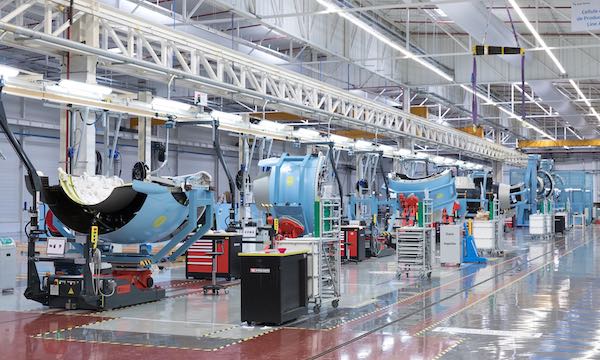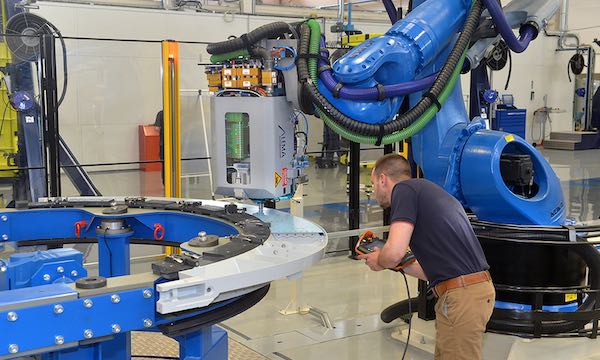Interview with Cédric Goubet (Safran Nacelles) : "It wasn't business as usual"
Interview by Léo Barnier
 le 04/07/2019 , Maintenance aéronautique le 04/07/2019 , Maintenance aéronautique
During the last Paris Air Show at Le Bourget, Safran Nacelles celebrated the delivery of its 1000th LEAP-1A engine nacelle for the A320neo. This event alone illustrated the hard work that the equipment provider has been putting in over the last few years to keep up with the pace set by Airbus. Cédric Goubet, Safran Nacelles CEO, looks back over this change in dimension for Le Journal de l'Aviation, as well as the other projects the company has in progress, in particular with Boeing.
You've celebrated the delivery of your 1000th nacelle for the LEAP-1A engine. How is the transition from the Airbus A320ceo to the A320neo going?
Our transition phase is very well advanced. We are reaching the long-scheduled end of production of the A320ceo, in which we are involved with the CM56 engine thrust reversers, after demand lasted much longer than planned. The precise timetable will be set by the manufacturer.
We had to pick up speed very quickly with the A320neo, which was completely unprecedented in our industry. Barely three years after the plane came into service, we have reached the 1000th nacelle, meaning the 500th aircraft equipped with the LEAP-1A. Today, there are no specific difficulties with this increased rate, which was one of the main challenges involved in this programme.
From the very start with Airbus and CFM, we had defined that not only did we need to develop this new propulsion system on deadline and according to the expected specifications, but straight away we also needed to prepare a very disciplined and tight ramp up plan with our procurement chain. This requirement was integrated from the nacelle design stage.
How have you adapted your production resources?
When it came to our level of preparation, it wasn't " business as usual ". We had to increase our capacities and think about production methods which would be much higher performing and competitive: partly automated assembly lines and the use of collaborative virtual reality, introduction of AFP processes (automatic fibre placement, ed.) to package components for reversers.
This programme has really enabled us and others to grow in industrialisation and operational excellence. With encouragement from Airbus, we have put review processes in place to evaluate our preparation and production maturity levels constantly and in depth, both in-house and externally with our suppliers.
We also had to work with more suppliers to keep control of risks, with a dual source principle, give or take a few exceptions. This is also the case in-house. The A320neo reversers are assembled in our Le Havre and Casablanca factories, which have perfectly comparable lines. This enables us to share knowledge and have catch-up capacities if any problems arise.
 Automated assembly line for LEAP-1A engine nacelles for the Airbus A320neo. © Safran / J. Lutt / CAPA
Automated assembly line for LEAP-1A engine nacelles for the Airbus A320neo. © Safran / J. Lutt / CAPA
Airbus is now talking about future increased rate. Are you ready for that now?
The initial ramp up isn't finished yet. We delivered the first nacelles in 2016, then over 200 in 2017 and over 400 last year. This year we'll manage to deliver around 600, which is a 50% increase, then get close to 800 nacelles in 2020.
We still have some way to go until 2022, with regular increases. This is clear given the number of planes assembled per month at Airbus and the LEAP-1A's market share. This market share has consolidated over time and has become the majority at around 55% or even a bit more.
The nacelle production volumes for the A330neo are very different. Is the preparation too?
Actually you can't compare everything. We still have a double-digit production rate, which is very demanding for products with this type of volume. We delivered the first A330neo nacelle last year and we had to really pick up speed straight away to meet growing customer demand.
We took advantage of what we learned from the A320neo about our industrialisation and production methods, but also about support for our nacelles in operation. This also enables us to provide even better service for the A330neo.
We have set up a highly automated line in Le Havre for the assembly and acoustic treatment of the transcowls (sliding part of the reversers, ed.). And we have designed it from a collaborative virtual space, to optimise performance and ergonomy directly, but also the health and safety at work of our operators.
You have just mentioned the importance of support in these workload increase phases; how do you set up your network to cope?
We have had a lot of entries into service with different operators over a very short period. This meant that we had to expand our support capabilities with teams which are able to both handle nacelle elements in our workshops but also go out to our customers for under-wing support. And staff numbers at our customer support centre (CSC) in Le Havre keep growing.
We also need to develop our MRO network worldwide, on our own and in partnership. Given the volume of elements on a nacelle, we need a certain level of regional proximity and have a presence on the different continents. We are expanding our American site and we are setting up additional capacity in China and South East Asia. It's Asia which will need the most attention over the next few years.
Airbus has launched initiatives to develop digital continuity with DDMS and Skywise. Where are you in relation to these areas?
We can see methods and tools evolving and of course we are working in this field. We need to advance at the same time as aircraft manufacturers, who are our main customers. The Safran group has the capabilities for this and has been starting a certain number of projects for several years now. Digital continuity enables us to develop a much better collaborative dynamic with the single digital model.
We have a project which is currently being deployed. This will improve the capacities of our digital design tools and insert them into a digital configuration management scheme for our products throughout their lifetime.
We are also working on using data, in a smart way with aircraft manufacturers and operators, to create value - with more predictive maintenance for example. This is in everyone's interest and we have found ways to operate.
 Robotic drilling and riveting cell for the A330neo's nacelles. © Safran / P. Boulen
Robotic drilling and riveting cell for the A330neo's nacelles. © Safran / P. Boulen
CFM International has made a proposal to Boeing for the NMA. Is this a project you could take part in?
Absolutely. When a customer such as Boeing has a new aircraft planned, we talk to them to persuade them that we can provide value. And this is independent of the choice of engine provider. Just like Airbus, Boeing get their nacelle elements directly from nacelle manufacturers, and Safran Nacelles works with everyone.
GE Aviation has been forced to announce delays with the GE9X, the engine for the Boeing 777X for which you are supplying the titanium nozzles. How is this affecting you?
We provide these nozzles directly to Boeing. For the moment, I haven't been informed of any recent changes to the roadmap as it relates to us.
Environmental issues were very much to the fore at this Paris Air Show. In terms of the nacelles, what are you doing to help reduce aircraft's environmental footprint?
The propulsion system is one of the main generators of gas emissions, especially CO2. We are determined to take part in raising awareness of environmental concerns, as we have already done with the neos. The A320neo has reduced fuel consumption by around 20% (calculated per seat in relation to the A320ceo, ed.) and halved the noise footprint. The figures aren't exactly the same for the A330neo, but very significant progress has been made.
We use R&T to improve our acoustic treatment and to optimise propulsion system weight, with new, lighter materials and innovative architectures.
We have pioneered a more electric aircraft with the A380 as we were the first to develop an ETRAS, an electric actuator for the thrust reversers. We are also thinking about de-icing and thermal regulation systems which would be based more on electricity. This enables us to save weight and the engine's energy is dedicated more to propulsion than to supplying other equipment, which helps reduce kerosene consumption.
Are you using additive manufacturing to achieve this?
Additive manufacturing is a game changer, which can generate significant room for manoeuvre in terms of design and production. We have a few projects in this area for nacelles: the metal structure elements have potential for this, such as beams or cascades (thrust reverser grills, ed.) which enable the reversed jet to be optimised to the maximum.
|